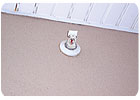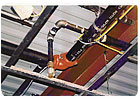The most commonly used steel pipe for sprinkler systems is black steel pipe. Copper tubing is another piping material listed for sprinklers in NFPA 13. Also, plastic pipe (namely, CPVC and PEX tubing) is permitted for certain types of sprinkler systems.
Editor’s Note: “Back to Basics” is a column that will run periodically in PM Engineer reviewing the basic principles of plumbing engineering. This month’s article takes a closer look at the most common types of sprinkler pipe.
Steel Pipe
Steel pipe has long been the mainstay of piping materials for sprinkler piping systems. Steel is considered strong, durable and resistant to fire. With a melting point of about 2,700°F, steel pipe can withstand the heat within a burning building.

An exterior sidewall sprinkler (piping exposed).
Steel pipe is available in both black and galvanized. Black pipe is bare steel pipe without a protective coating. Galvanized steel pipe is hot- dipped in zinc to have a protective coating on the walls of the pipe. The zinc coating (galvanizing) acts as a sacrificial anode to reduce the corrosion of steel pipe.
The most commonly used steel pipe for sprinkler systems is black steel pipe. Since the piping system is a stagnant system, the impact of corrosion is minimized. The oxygen within the water is quickly dissipated, thus reducing the corrosion potential.
NFPA 13 lists three standards for steel pipe: ASTM A53, ASTM A135 and ASTM A795.
ASTM A53 is the standard that regulates standard weight, extra strong and double extra strong steel pipe for general use. Standard weight pipe is also called Schedule 40 steel pipe. Similarly, extra strong is called Schedule 80 and double extra strong is called Schedule 160. The Schedule number equates to the wall thickness of the steel pipe. The lower the schedule number, the thinner the wall of the pipe. For a sprinkler system, only Schedule 40 is used. However, there is no prohibition of using a heavier wall pipe.
ASTM A135 is a general-use, electric resistance welded steel pipe. Electric resistance welded (or ERW) is the common method of making steel pipe. The flat steel is formed into pipe and welded. The welded seam is normalized to reduce the potential for corrosion. ASTM A135 allows the pipe to be a lighter wall thickness. The pipe is referred to as light wall steel pipe. Anytime the expression light wall is used, it indicates that the wall thickness is less than a Schedule 40 steel pipe. When using the Schedule numbers, light wall steel pipe is typically in the range of Schedule 10.
ASTM A795 is steel pipe for fire protection use. This standard allows the pipe to be welded or seamless, black or galvanized. The wall thickness of the pipe can be light wall (Schedule 10), Schedule 30 and Schedule 40.
The minimum size pipe permitted for a steel sprinkler system is 1-inch pipe.
Steel pipe for sprinkler systems can be joined by threaded joints, welded joints, rolled groove and cut groove. Threading is only permitted for Schedule 40 or heavier pipe. However, if a lighter wall pipe is specifically listed by a testing laboratory for threading, then NFPA 13 (National Fire Protection Association) will permit the lighter wall pipe to be threaded.
Welding is required to be performed by a certified welder. Any steel pipe is permitted to be welded.
A cut groove connection is only permitted on Schedule 40 and heavier piping for pipe under eight inches in diameter, and Schedule 30 for eight inches and larger in diameter. Cut groove joints cut a straight groove into the wall of the pipe to allow the connection of a grooved fitting. The joint is sealed with an elastomeric gasket.
Rolled groove joints roll an indentation into the end of the pipe, rather than cutting a groove. Any wall thickness of pipe can be roll grooved.
Listed joints also are permitted for steel pipe. There are a number of listed mechanical fittings and couplings. Most mechanical joints rely on an elastomeric gasket or seal to make the connection.

An exterior sidewall sprinkler (piping hidden).
Copper Tubing
Copper tubing is another piping material listed for sprinkler use in NFPA 13. The three copper tubing standards listed are ASTM B75, ASTM B88 and ASTM B251. The copper tubing can be either Type K, L or M. The type indicates the wall thickness, with Type M being the lightest wall and Type K being the heaviest wall thickness.
The minimum size tubing required for copper sprinkler systems is 3/4 inch.
Copper tubing is required to be joined by brazing unless soldering is permitted. NFPA 13 allows soldering for wet piping installations in light hazard occupancy sprinkler systems.
Copper tubing also can be joined by fittings that have been listed by a testing agency. This would include various mechanical joints that use an elastomeric gasket or ring to make the seal. Certain press connect fittings have been listed for sprinkler use.
Codes permit both copper tubing and steel pipe to be bent. However, the bending of the tubing or pipe cannot distort the pipe.

A maze of black piping in non-combustible concealed spaces supplies pendant sprinklers for a hospital corridor. Source: Mark Bromann.
Plastic Pipe
Plastic pipe also is permitted for certain types of sprinkler systems. The plastic pipe is required to be listed by a testing agency. NFPA 13 identifies CPVC (chlorinated polyvinyl chloride) and PB (polybutylene) as acceptable plastic piping materials. While PB is listed in NFPA 13, the piping material has not been available in North America for approximately 15 years.
The CPVC used in sprinkler installations is also called Blazemaster. The pipe is orange in color.
CPVC is listed for residential use, light hazard use and limited ordinary hazard use. Blazemaster also is listed for potable water use for multipurpose piping systems regulated by NFPA 13D.
CPVC is a limited combustible piping material; therefore, it must be installed to prevent the pipe from failing during a fire. One of the options is to protect the pipe with a layer of gypsum wallboard or plywood. Lay-in ceiling tiles that are clipped in place may also be used to protect CPVC.
CPVC also is permitted to be exposed when it is piped tight to the ceiling. In unfinished basements of one- and two-family dwellings, CPVC can be exposed when attached to the bottom of the wood joist. The minimum size CPVC pipe permitted for a sprinkler system is 3/4 inch.
CPVC is joined by solvent cementing. The solvent cement is a one-step solvent cement that is red in color. Priming of the joint is not required. The sprinkler is not permitted to be threaded in place when making a solvent-cemented joint. The concern is that the solvent cement will run into the sprinkler and block off the opening in the event of a fire.
CPVC pipe is required to have the hangers spaced at closer intervals than metallic pipe. Another requirement regarding the support of CPVC is at the drop to sprinklers. The pipe must be supported within a short distance of the drop to prevent the movement of the pipe and sprinkler during a fire.
When used in an antifreeze sprinkler system, CPVC can only have glycerine antifreeze. Glycol-type antifreeze solutions are specifically prohibited since they may be detrimental to the pipe.
The other plastic piping material that is listed for sprinkler use is cross-linked polyethylene (PEX). PEX tubing has only been listed for use in one- and two-family dwelling systems regulated by NFPA 13D. These types of systems are installed in detached one- and two-family dwellings as well as townhouses.

A full range of CPVC fire sprinkler piping products. Source: Harvel Plastics.
PEX tubing must be protected from fire similarly to CPVC pipe. The tubing cannot be exposed and must have a layer of gypsum wallboard, plywood or lay-in ceiling tiles protecting the tubing.
The PEX tubing is flexible and can be bent when installing the tubing. Fittings also can be used to make changes in direction. The joining method for PEX tubing is mechanical joints. The fittings must be a part of the listing for the PEX tubing.
Because PEX is extremely flexible, the sprinkler must be firmly attached in place during installation. The listing of the PEX tubing specifies the type of connection of the sprinkler that is required. The attachment prevents the movement of the sprinkler during a fire.
PEX tubing is listed for 1/2-, 3/4-, and 1-inch sizes. While 1/2-inch tubing is not a normally accepted pipe size for sprinkler systems, it is permitted for PEX systems that are looped. When using 1/2-inch tubing, each sprinkler must have multiple connections of tubing. This will allow the minimum flow requirements for the sprinkler to be satisfied.
Hangers used for any piping system that conforms to NFPA 13 or 13R are required to be listed. There is an exception for metal clevis hangers and metal U hook hangers that are fastened by screws. For sprinkler systems conforming to NFPA 13D, the hangers must meet the requirements of the plumbing code.

